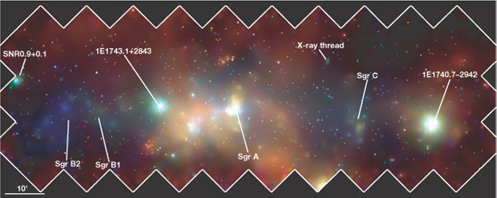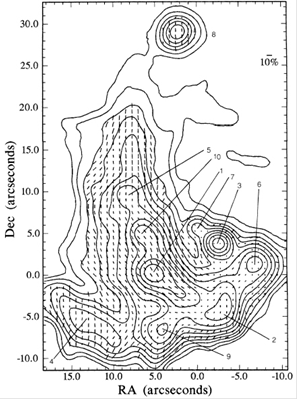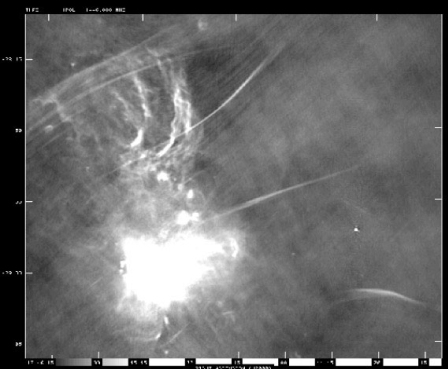
The Galactic Center magnetosphere
 المؤلف:
Heino Falcke and Friedrich W Hehl
المؤلف:
Heino Falcke and Friedrich W Hehl
 المصدر:
THE GALACTIC BLACK HOLE Lectures on General Relativity and Astrophysics
المصدر:
THE GALACTIC BLACK HOLE Lectures on General Relativity and Astrophysics
 الجزء والصفحة:
p 102
الجزء والصفحة:
p 102
 26-1-2017
26-1-2017
 2213
2213
The Galactic Center magnetosphere
The magnetic field in the inner few hundreds of parsecs of the Galaxy has been somewhat of a surprise, inasmuch as it has been found to be unexpectedly strong (milligauss versus a few microgauss in the Galactic disk), apparently highly ordered, and characterized by a completely different geometry (dipolar) from the field in the Galactic disk (toroidal).

Figure 1.1. False-color mosaic image of X-ray emission from the Galactic Center region, from Wang et al (2002). This image covers a band of about 2o × 0.8o in Galactic coordinates (300 × 120 pc), and is centered at l = -0.1o, b = 0o, roughly the location of the Sgr A complex. The three energy bands are 1–3 keV (shown in red), 3-5 keV (green), and 5–8 keV (blue). The image was compiled from 30 separate pointings acquired with the Advanced CCD Imaging Spectrometer (ACIS-I). The intensity is plotted logarithmically to emphasize low-surface-brightness features.
There are several ways of probing the magnetic field at the Galactic Center, and all have been used to study the Galactic Center field (Morris 1994, 1998; Morris and Serabyn 1996 and references therein):
(1) the Zeeman effect in the spectral lines of OH and HI,
(2) Faraday rotation of polarized background radio emission,
(3) the orientation of the polarization vectors of the thermal emission from magnetically aligned dust grains,
(4) the filamentary morphology of synchrotron-emitting structures and
(5) the intrinsic orientation of the polarization vectors in the synchrotron emitting structures.
An example of an application of the third method is shown in figure 1.2, taken from Aitken et al (1998).
Filamentary radio structures which delineate the magnetic field (method 4) are illustrated in figure 1.3. These structures are representative of about a dozen filamentary radio systems, the most prominent of which is the bundle of filaments constituting the Galactic Center Radio Arc (situated at the top of figure 1.3, and not well represented in this radiograph because of its distance from the center of the field). These non-thermal radio filaments (NTFs) generally share several characteristics (Morris 1996):
(1) Their radio emission is highly polarized synchrotron radiation, and when the polarization vectors are corrected for Faraday rotation by the intervening

Figure 1.2. Vectors orthogonal to the 12.5 μm polarization vectors measured toward Sgr A West by Aitken et al (1998), superimposed on contours of the surface brightness at that wavelength. These vectors are probes of the magnetic field direction to the extent that the emitting dust grains have been collectively aligned by the magnetic field. Note how the magnetic field follows the Northern Arm, the north–south structure which is a stream of dust and gas falling towards, and orbiting partially around, the black hole.
medium, they are found to be perpendicular to the filaments, indicating that, not surprisingly, the magnetic field is aligned with the filaments.
(2) They are typically quite long: 20-50 pc, and narrow: less than 0.3 pc.
(3) With one exception, the NTFs all have a gentle, smooth curvature with no

Figure 1.3. The radio ‘threads’ observed toward the Galactic Center with the Very Large Array (VLA) at a wavelength of 20 cm (Lang et al 1999). Other filamentary systems are evident as well. Note the strikingly large scale of the radio filaments; the 5 arcmin between tick marks on the vertical axes corresponds to 12.5 pc.
gross deformations. The exception is the ‘Snake’, or G359.1-00.2 (Gray et al 1995), which shows a few kinks along its length.
(4) All of the NTFs within a projected distance of 150 pc of the Galactic Center are approximately perpendicular to the galactic plane.
The generally smooth curvature of the NTFs has been used as evidence for a high rigidity of the magnetic field. That is, the magnetic field strength must be of the order of a milligauss in order to not show distortions resulting from inevitable (and observed) interaction with the tumultuous interstellar medium at the Galactic Center. A milligauss magnetic field has a tremendous pressure compared to other sources of interstellar pressure in the Galactic Center region, so it is unlikely that the NTFs are isolated, because in that case, their internal pressure would cause them to expand explosively. Self-confinement of isolated, force-free magnetic field configurations has been considered, but this hypothesis does not solve the problem that the filamentary structures will expand and dissipate without some confining medium. The confinement of the field is assured, however, if the magnetic field in the central 150 pc of the Galaxy is ubiquitous and approximately uniform. Then the NTFs represent locations where the more or less uniformmagnetic field is ‘illuminated’ by the local injection of relativistic electrons. The filamentary morphology can be understood in terms of the fact that the large-scale field constrains these electrons to diffuse only parallel to the magnetic field lines. The overall picture indicated by the orientation of all the filaments is that of a dipole field with perhaps some divergence above the Galactic plane. The confinement and stability of a strong central field have been discussed recently by Chandran (2001).
The NTFs define the magnetic field in the intercloud medium. Within molecular clouds, the magnetic field orientation has been measured using the far infrared polarization of the thermal emission from dust grains and found to be quite different: largely parallel to the Galactic plane (Hildebrand et al 1990, 1993; Morris et al 1992; Morris and Serabyn 1996; Novak et al 2000). While the magnetic field strength is not directly determined by this method, the striking uniformity of the orientation of the polarization vectors measured at adjacent positions suggests that it is at least as strong as the field in the intercloud medium (following the arguments of Chandrasekhar and Fermi 1953). The orientation of the field within clouds can be attributed to the shear to which molecular clouds are subjected there (Aitken et al 1998; Morris et al 1992).
The rough orthogonality of the cloud and intercloud fields raises the possibility that field line reconnection could be a mechanism for particle acceleration within the filaments. This mechanism was explored by Serabyn and Morris (1994), who argued that the reconnection process is most effective where the cloud surface is ionized, presumably by a fortuitously nearby star, and where the cloud is moving with respect to the ambient magnetic field. The HII region at the cloud surface provides two things: turbulence, which mixes the cloud and intercloud fields and fosters their reconnection; and the electrons which are thereby accelerated. So far, every NTF which has been sufficiently well studied can be connected with a surficially ionized molecular cloud somewhere along its length (e.g. Uchida et al 1996; Kramer et al 1998; Staguhn et al 1998). However, further evidence is needed to establish this hypothesis, such as a demonstration that the spectral indices of the NTFs always steepen away from the presumed acceleration site as the emitting electrons lose energy.
How is the strong, vertical magnetic field at the Galactic Center produced? No dynamo models have yet successfully produced a strong dipole field at the Galactic Center. The one extant model that can account for it posits that the central field simply results from the slow inward migration, over a Hubble time, of partially ionized gas, to which the vertical component of the protogalactic magnetic field is effectively frozen (Sofue and Fujimoto 1987; Morris 1994; Chandran et al 2000). The field component parallel to the Galactic plane follows a different history; it can be lost by drifting vertically out of the thin Galactic disk by ambipolar diffusion, but along the way it can be amplified by differential rotation and other dynamo processes. In any case, the vertical component is the only one which can be concentrated at the center.
All the evidence we have from measurements made at large spatial scales indicates that matter that accretes onto the black hole from the interstellar medium is relatively strongly magnetized. Even if the accreting matter comes predominantly from the winds of the massive stars near the central black hole, those stars, and thus their winds, are presumably quite strongly magnetized, given that they recently formed out of such highly magnetized material as is present in the CMZ.
 الاكثر قراءة في الثقوب السوداء
الاكثر قراءة في الثقوب السوداء
 اخر الاخبار
اخر الاخبار
اخبار العتبة العباسية المقدسة


